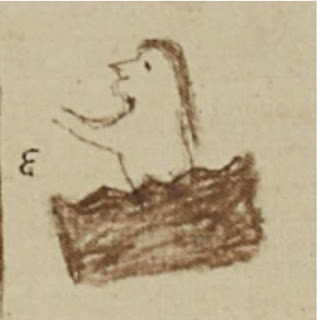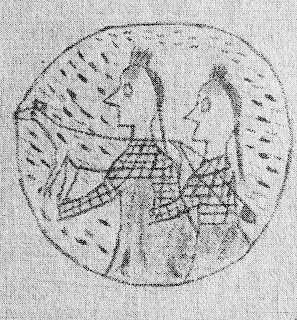A Corps of Discovery Bicentennial medallion is on display near the visitor center at Fort Abraham Lincoln State Park.
Forgotten History At State Park
Omission Of Prison Camp Narrative
By Dakota Wind
Mandan, ND – On the night of October
21-22, 1804, the Corps of Discovery established camp above the abandoned Mandan
Indian Village known today as On-A-Slant, located at present-day Fort Abraham
Lincoln State Park. Their mission, one of exploration and science, but also one
of peace and friendship.
Seventy-three years later, on October 5,
1877, the Nimiipuu (Nez Perce) concluded a running battle from their homelands
in Idaho to Bear Paw Mountain, MT, heart-breakingly short a few miles to
US-Canadian border. Their destination: Fort Walsh, to live amongst Sitting Bull
and the Hunkpapa Lakota, whom the Nez Perce thought would assist them. Nearly
800 Nez Perce were captured by Col. Miles. 300 of the Nez Perce were imprisoned
at Fort Abraham Lincoln in October, 1877, as they were prepared to be shipped
to Indian Territory (OK). Some of them died, as prisoners of war, at Fort
Abraham Lincoln.
Among the 300 Nez Perce prisoners of war
was Tzi-Kal-Tza, or Daytime Smoke, an elder at seventy-one/two
years, who survived the military’s single-minded pursuit of his people, had
actually fought to defend his people in the Nez Perce War, and was part of
their subsequent capture at the Bear Paw conflict, and their relocation to
Indian Territory (OK). Information at the Nez Perce County Historical Museum in
Lewiston, ID, says that Daytime Smoke was the son of Captain William Clark.
The son of Captain William Clark, Daytime Smoke, who was imprisoned at Fort Abraham Lincoln in October, 1877, where his father once stepped.
The imprisonment of the Nez Perce
survives in living memory today, which isn’t so long ago as one would imagine. “My
great-grandmother’s sisters, two of them, died there,” shared Mr. Woodrow Star,
an enrolled member of the Nez Perce tribe. “I paid a visit to Fort Lincoln to
visit my grandmothers’ graves. None of the park rangers, not even the park
manager, had ever heard of this.”
After the fort was decommissioned in
1890, all veterans and citizens at rest there – including the POWs, were
exhumed and reinterred at St. Mary’s Cemetery. The Nez Perce were buried in a
line, their names unrecorded. Their graves in Bismarck lie there still, in
unmarked graves. The Nez Perce today, want to change this.
Fort Abraham Lincoln has seen a lot of
reconstruction over the years. Blockhouses and the museum/visitor center have
been in place in the 1930’s. Earthlodges were originally reconstructed by the
CCC in the 1930’s too, then reconstructed as needed. In the late 1980’s the
commanding officer’s quarters were reconstructed, built as General Custer would
have known it in 1875. Four other buildings followed. The museum/visitor center
was renovated to feature the Mandan Indian and military occupations.
The visitor center features an area dedicated to representing the overnight stay of the Corps of Discovery within present-day Fort Abraham Lincoln State Park.
The museum/visitor center displays
feature archaeological findings both from the Mandan and military, Sheheke,
(White Wolf; White Coyote) a Mandan who was born there, an artistic diorama of
the historic Mandan village there, Fort Abraham Lincoln, General Custer, and
the Civilian Conservation Corps. The Little Bighorn campaign and battle are
also featured, as is the Corps of Discovery.
Guided tours of the commanding officer’s
quarters (“The Custer House”) are offered throughout the tourist season. The
guides are dressed in period attire and speak in the present tense as though
it’s 1875 rather than the modern day. The Custer House features various
novelties that once belonged to Lt. Col. G.A. Custer and his wife. These are
pointed out to the visitor by way of a prompt, “Take special notice of…”
The fort’s history is summarized in a
prologue and conclusion of every tour: it was built in 1873, a cavalry post to
protect the Northern Pacific Railway survey crews, the Black Hills Expedition
of 1874 (to confirm the discovery of gold) receives a mention, the Little
Bighorn Campaign (Centennial Campaign), the plight of Elizabeth “Libby” Custer
following the failure of her husband’s command, the decommission of the fort,
citizens dismantling the fort for construction materials in their homes, the
CCC placing building markers, and the reconstruction of the fort.
Fort Abraham Lincoln State Park's interpretive programming focuses heavily on the military occupation of the site from 1872 to 1890.
What is entirely missing from the
narrative in the interpretive programming and the museum information about the
military occupation is the prison camp history. There is no mention either of
the 1875 Treaty of Fort Abraham Lincoln, which was a big activity there at the
fort. Lt. Col. Custer called on members of the Arikara, Hidatsa, Hunkpapa
Lakota, Mandan, and Yanktonai Dakota to end their generations-long intertribal
warring.
The interpretive training that seasonal
staff at Fort Abraham Lincoln State Park receive is based on the practices of
Freeman Tilden. There are six principles in this methodology. Tilden’s
principles are the basics of all interpretive programming found in the National
Parks, state parks, museums, and other institutions across the country. Tilden’s
principles are:
Tilden's work began with a focus on state parks before his work on interpretive programming was picked up by the National Park Service.
1. Any interpretation that does not
somehow relate what is being displayed or described to something within the
personality or experience of the visitor will be sterile.
2. Information, as such, is not
interpretation. Interpretation is revelation based upon information. But they
are entirely different things. However, all interpretation includes information.
3. Interpretation is an art, which
combines many arts, whether the materials presented are scientific, historical
or architectural. Any art is in some degree teachable.
4. The chief aim of Interpretation is
not instruction, but provocation.
5. Interpretation should aim to present
a whole rather than a part, and must address itself to the whole man rather
than any phase.
6. Interpretation addressed to children
(say, up to the age of twelve) should not be a dilution of the presentation to
adults, but should follow a fundamentally different approach. To be at its
best, it will require a separate program.
Artistic licence was used to create this reconstruction of the On-A-Slant Mandan Indian village. The layout is slightly different, and according to the archaeological report, there was no ceremonial lodge.
An informal visit to the North Dakota Parks
and Recreation Department on Thursday, August, 25, 2016, and message for the
director went unanswered. An email to the Fort Abraham Lincoln State Park
received a reply on Oct. 15, 2016, but only to say that the park manager would
respond “next week.” There has been no further follow-up from the North Dakota
Parks and Recreation Department.
The original post cemetery was located at the top of the bluff near old Fort McKeen.
Mr. Woodrow Star humbly requested any
and all information that the North Dakota Parks and Recreation could share with
him about his relatives imprisonment. The staff could not respond to Mr.
Woodrow, because their information is woefully incomplete. Fort Abraham Lincoln
State Park does not employ an actual historian to research and construct their
interpretive program. In October of 2015, the park manager referred Mr. Star to
me.
Here’s follows a bibliography of non-native primary resources which specifically mention the Nez Perce in Bismarck and at Fort
Abraham Lincoln in October of 1877.
Primary Resources:
Fred G., Bond. “Floatboating On The Yellowstone.”
1st Ed. New York, New York: New York Public Library, 1925. 1-22.
Miles, Gen. Nelson Appleton. "The Nez Perce
Campaign & The Siege And The Surrender." In Personal Recollections And
Observations Of General Nelson A. Miles, 250-280. 1st Printing. New York, New
York: Werner Company, 1896.
Zimmer, William F. "Part Two: August 1,
1877 to December 31, 1877." In Frontier Soldier: An Enlisted Man's
Journal, Sioux And Nez Perce Campaigns, 1877, edited by Jerome Greene, 89-160.
1st ed. Helena, Montana: Montana Historical Society Press, 1998.
Journals:
Romeyn, Capt. Henry. "The Capture Of Chief
Joseph And The Nez Perce Indians." Contributions To The Montana Historical
Society, Vol. 2 (1896): 283-91.
Haines, Francis. "Nez Perce Indians."
Army And Navy Journal, 1877, 290-91.
Magazines:
Henry Remsen, Remsen (Tilton). "After The
Nez Perces." Field And Stream And Rod And Gun, December 1, 1877, 403-04.
"The Surrender Of Joseph." Harper's
Weekly, November 17, 1877, 905-906.
Newspapers:
Bismarck Tri-Weekly Tribune, November, 21 &
23, 1877.
Cheyenne Daily Leader, November 25, 1877.
Inter-Ocean, November 23, 1877.
The Nez Perce themselves know their own history. They survived
displacement from their homelands, imprisonment, and placement in Indian
Territory (Oklahoma).
Goplen, Former Senior Foreman Historian for the National Park
Service minimized this tragedy to half a paragraph and displaced the locality
to Bismarck, ND. Fort Abraham Lincoln State Park staff have repeatedly ignored
calls to address the omission of this history in an effort to preserve the
lionized integrity of an egotistical and incompetent military commander. The Fort Abraham Lincoln State Park website focuses only on the Mandan Indian and military occupations and provides a link to Little Bighorn History. There is a pattern of omission of historical fact that is taking place at Fort Abraham Lincoln State Park. One can only hope that this changes.
Visit this park. It's still the greatest park in North Dakota. Ask the park manager to develop the interpretive narrative. It doesn't need to be apologetic. It needs to be informed.
































